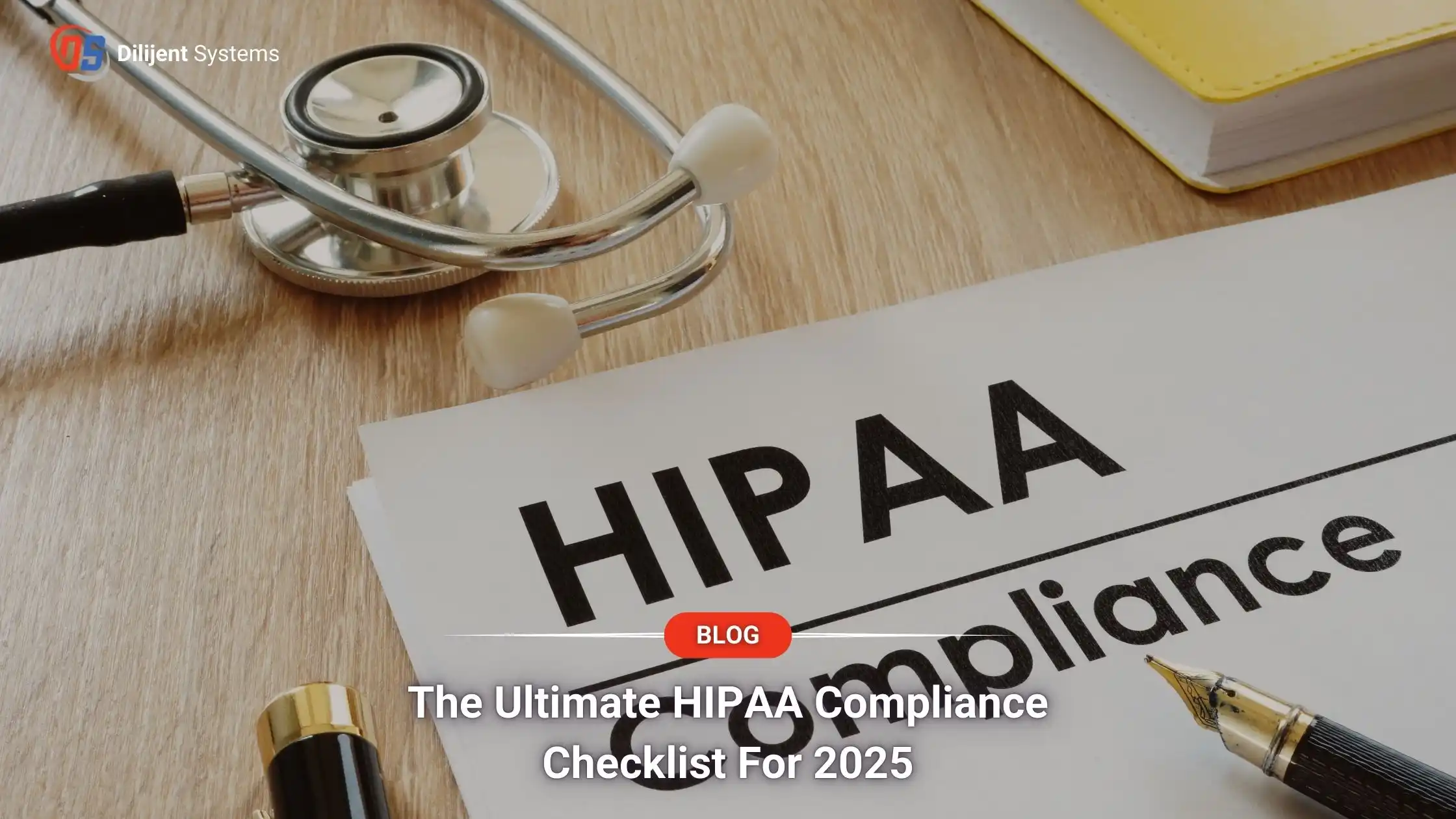
In 2025, healthcare will be one of the biggest industries facing cyber threats and security issues. Patient data is very important and if you fail to protect it, you will have to face big consequences.
That’s why US federal laws implement a Health Insurance Portability and Accountability Act (HIPAA) that is a cornerstone for protecting patients' information and ensuring cybersecurity.
HIPAA is no joke. Do you know that if your healthcare company fails to follow HIPAA rules and regulations, the minimum penalty is $50,000?
This is too much right?
Apart from the hefty price, you and your healthcare business might end up getting its name listed on the OCR’s Wall Of Shame with all the details of violation, penalty, and number of individuals affected.
Then it’s time for you to focus on HIPAA and see what you can do to make your healthcare business compliant with HIPAA rules and regulations.
This blog will take you through the detailed HIPAA compliance checklist so you can implement these steps and techniques in your healthcare business. HIPAA rules might be different for different organizations which makes it more confusing, hence read this blog and see how your business lacks in complying with HIPAA.
Getting a HIPAA compliance companion can sort out all the issues. If you are the head of your business or even a practicing doctor, we don’t expect you to be proficient in HIPAA rules and strategies.
That’s why getting a complaint partner like Dilijent Systems will be the best choice. We offer HIPAA compliance services at a very affordable price to make sure that your business doesn’t have to pay the hefty fine prices.
Who Needs To Follow The HIPAA Compliance Checklist?
There are different companies and organizations associated with healthcare. You need to see in which criteria your business lies and what rules you need to follow.
Mostly, healthcare providers, doctors, clinics, pharmacies, insurance companies, government programs, and clearing houses, need to keep up with the HIPAA compliance checklist. Other businesses associated with healthcare such as medical billing companies and audit companies, also need to comply with HIPAA.
8-Step HIPAA Compliance Checklist for 2025
Here’s an 8-step HIPAA compliance checklist that you should follow:
-
Determine Applicability of the Privacy Rule
First of all, you need to see if your organization is covered by HIPAA. Healthcare providers, healthcare plans, healthcare clearing houses, and entities that are responsible for the transfer of information are entitled under HIPAA. Business associates that are associated with your business by providing any type of service are also included under HIPAA.
After understanding your position you can easily assess your responsibilities under the HIPAA rules. This will help you in protecting PHI (Patient Health Information). You should make sure that PHI is not accessed or disclosed without any valid reason or authority.
-
Identify and Protect the Right Types of Patient Data
In the next step, there are different types of patient data from names and general information to insurance information. You need to identify all types of patient data and make sure you keep it safe and secure. You need to recognize what constitutes PHI within your organization.
PHI includes any information that is linked to their health status, provision of healthcare, diagnosis and treatment, and payment processes. The main items in PHI are:
-
Names, addresses, and birth dates
-
Social Security numbers
-
Medical records and histories
-
Insurance information
-
Any other unique identifying numbers or characteristics
See where all the PHI information is stored who has access to it and who uses it. All these precautions and steps will help you in preventing cyber breaches and information theft.
-
Understand HIPAA Security Rules and Safeguards
Protecting electronic Protected Health Information (ePHI) is the main goal of the Health Insurance Portability and Accountability Act's HIPAA Security Rule. Any patient health information generated, saved, transmitted, or received electronically is referred to as ePHI.
This includes data kept on emails, phones, computers, and cloud computing platforms. To ensure that this sensitive data remains secure, confidential, and shielded from risks like hacking, illegal access, or data loss, the Security Rule was created.
The HIPAA Security Rule mandates that covered entities and business associates implement three different kinds of safeguards—administrative, physical, and technical—to protect ePHI. Together, these three domains create a robust security framework for electronic health information.
Administrative Safeguards
The policies, plans, and procedures your organization must adhere to in order to protect ePHI are known as administrative safeguards. These guidelines serve as a guide for your daily data security management.
First and foremost, your company must designate a person to supervise HIPAA security compliance. This individual makes sure that everyone in the organization is abiding by the rules.
The next step is to specify exactly who can access what patient data and for what purposes. Not all information should be accessible to every employee. Roles and responsibilities must determine how access is restricted.
All employees must participate in training programs developed by your organization. Everyone should be aware of what HIPAA is, why it matters, and how to abide by the privacy policies of your company.
Physical Safeguards
The actions your company takes to physically secure the locations and equipment that handle or store ePHI are known as physical safeguards. This entails ensuring that unauthorized individuals are unable to access computers used to store patient data or enter rooms where data is kept.
File cabinets, server rooms, and even laptops need to be stored in safe places. Only authorized personnel should possess keys or access cards, and doors may require locks.
Devices such as laptops, tablets, and flash drives that employees take off-site need to be secured. Never leave them in unlocked offices, cars, or other dangerous locations. To prevent theft or unintentional damage, devices should be handled with care and stored securely.
Technical Safeguards
Using technology to protect patient data shared or stored via electronic systems is known as technical safeguarding. Limiting who can access your systems is the first step in this process. Every worker ought to have a distinct username and password.
In order to prevent data from being inadvertently left open, the system should be configured to lock users out after a certain amount of inactivity.
Encryption is another important component of technical protection. Anyone without the proper key or password cannot read data that has been encrypted. This implies that the thief won't be able to decipher an email or file that is stolen during transmission. To guard against malware and hacking, firewalls and antivirus software are also essential.
-
Conduct a Comprehensive Risk Assessment
A risk assessment is like a health check for your data security. You need to track down where all the important ePHI electronic patient health information is stored. Determine who has access to all the information for instance who stores the information, who shares it, and who can access it easily.
Then you need to see the pain points in your data security, which means where there is the highest possibility of data breach or theft. After pointing out the sensitive area, you need to make a report about your evaluation.
After that take significant steps to solve that problem. For instance, if your data software is weak you need to update the software. You can also add new data security tools to those software. After all, you need to carefully assess the honesty and diligence of the workers who are handling this process.
Risk assessment should not be done just once. You need to regularly keep an eye on all the processes to make sure everything complies with HIPAA.
-
Implement Necessary Policies and Procedures
To remain HIPAA compliant, your organization needs certain rules. No organization or business can survive without proper rules and regulations and especially when you have to follow a certain federal law you need to be much more conscious.
For this, make a comprehensive list of policies and laws to implement across your administrative staff. Add points like how to handle patient data, where to store it, whom to share it, and things like that. If you want a more practical approach introduce a fine for personnel who don’t follow these policies. This will help a lot in staying HIPAA compliant.
-
Train Your Staff
Even with the best security measures in place, a single employee error can lead to a data breach. That's why educating your employees is a large part of HIPAA compliance. Every individual in your organization, whether new or experienced, needs to know what HIPAA is and how to abide by its regulations.
Training must be simple and tailored to each employee's job. For instance, a billing person may require different training than an IT person. Everyone must understand how to manage patient information securely, what to do if they notice something unusual, and how to report issues.
Training must occur not only once, but consistently—particularly if there are updates to your systems or policies. Make a record of each training session and have employees sign to ensure that they've attended. This documentation is useful to demonstrate that your company is doing everything it can to remain compliant.
-
Manage Business Associate Agreements (BAAs)
Sometimes your organization needs to work with other companies such as medical coding and billing companies, IT service providers, and cloud storage providers. These are the entities that have access to your PHI. thus, you need to maintain strong agreements and contracts to prevent any fraud or breach.
In this case, BAA is a string agreement that clearly states how an associate company can use your data. This agreement is called a Business Associate Agreement (BAA) and is mandatory in your business relations.
However, your job doesn’t end after signing the agreement. You need to keep an eye on your business associates to ensure that they are not using your PHI for any other purpose. This is because your organization will have to suffer too if any such thing happens.
-
Prepare for Breach Notification and Response
Data breaches can still occur even with robust security. When they do, what matters is how fast and accurately you react. HIPAA has stringent guidelines for what to do in the event of a data breach, particularly when patient data is at stake.
You must first have a well-defined plan for handling a breach. This entails assembling a team to manage the matter, determining the cause of the breach, and taking action to prevent additional harm.
The individuals whose data was impacted must then be informed. In extreme circumstances, you might also have to notify the media and the Department of Health and Human Services (HHS).
Maintaining thorough documentation of the breach and your response is also essential.
Final Words
HIPAA is a US federal law and everyone who is related to healthcare and has patient’s data has to follow it. Thus if you are also someone dealing with patients' data in the USA, you need to learn about the complete HIPAA compliance checklist. The above blog gives a comprehensive detail on the 8 steps of the checklist. You must follow these steps to ensure data privacy.
FAQS
What is HIPAA compliance?
HIPAA is a USA federal law that protects sensitive patient information. Every business dealing with patient information has to comply with HIPAA.
What is the main key to HIPAA compliance?
Maintaining key details and information is the key to HIPAA compliance. Make sure you have 100% authority over all the patient data.
What is a compliance checklist?
A compliance checklist is an 8-step procedure that makes sure your business is abiding the HIPAA law. HIPAA law is for the protection of patient information.


